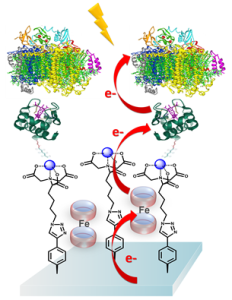Drawing inspiration from natural photosynthesis the scientific community is on the quest for the development of advanced and more sustainable functional materials for solar energy conversion by merging sophisticated biomachineries with various synthetic materials. Whilst complex molecular biomachines have been optimized in their natural environment throughout billions of years of evolution, their viable implementation in artificially engineered devices remains a major challenge. In particular, in the Solar-to-X, biosensor and bioelectronics fields, a key aspect for the significant performance improvement resides in the effective electrical wiring between biological electroactive molecular machines (e.g. photoenzymes, hydrogenases and CO2 converting enzymes) and electrode surface. To overcome the limited direct electrical conduction at the abiotic-biotic interface, a commonly used approach relies on the application of excessive amounts of toxic redox mediators, limiting therefore the sustainability, long-term performance and industrial implementation of such systems.
In this context, a recent article published in the prestigious journal Materials Horizons of the British Royal Society of Chemistry reports an innovative strategy to significantly enhance electron transfer (ET) at the abiotic-biotic interface of solar converting devices based on robust Photosystem I (PSI) photoenzyme. The novel breakthrough strategy involves doping the molecular interface with the space-confined carbonaceous mediator, ferrocene dimethanol (Fc), used at minute (nM) concentrations.
By rationally designing the molecular interface to covalently immobilize in an oriented manner the PSI biophotocatalyst, we discovered the possibility to entrap the molecules of the sustainable and quite underexplored Fc mediator, within the organic conductive interface between PSI and the electrode. The development of the newly and accidentally discovered Fc-confined molecular interface allowed us to improve the long-term performance of biosolar cells for more than 5 months.
Our novel concept of space-confined electron transfer provides a sustainable approach to maximize the efficiency of biosolar devices while avoiding the detrimental effects and competitive interference of external usually toxic mediators in a variety of applications ranging from biophotovoltaics and solar fuels production, through to biocatalysis and biosensing. As such, our discovery opens a new avenue for efficiently interfacing biomachineries with functional materials, offering a true breakthrough in the quest for viable, highly performing biomolecular technologies.
This international collaborative work was led by Dr. Margot Jacquet and Prof. Joanna Kargul (Solar Fuels Lab, Center of New Technologies, University of Warsaw), and involved several groups from CeNT UW, the Faculty of Chemistry/CNBCh UW, the Faculty of Physics UW, and the National Research Council of Italy (CNR).
Full citation:
More info about the research at the Solar Fuels Laboratory: https://cent.uw.edu.pl/en/laboratories/laboratorium-fotosyntezy-i-paliw-slonecznych/



